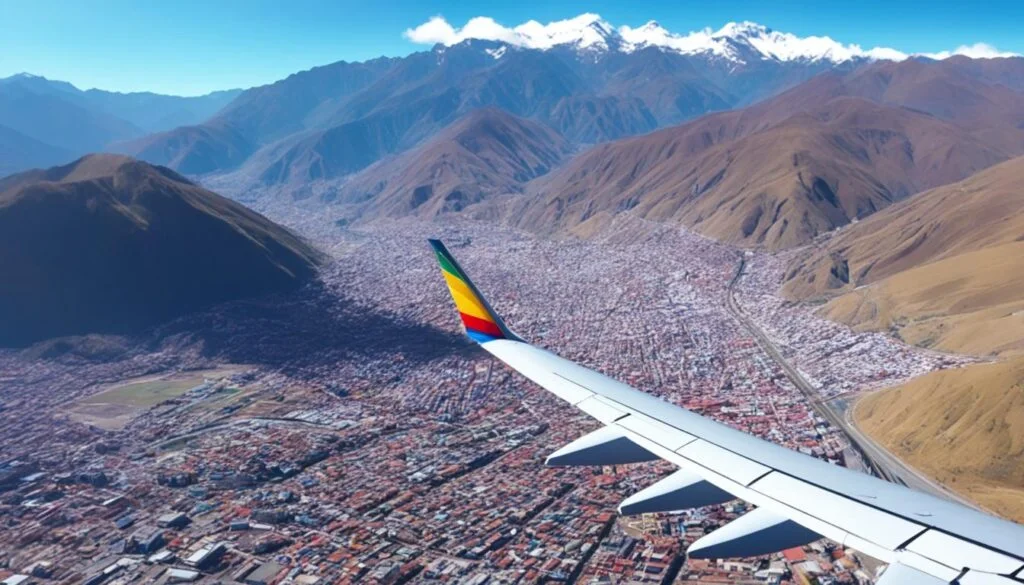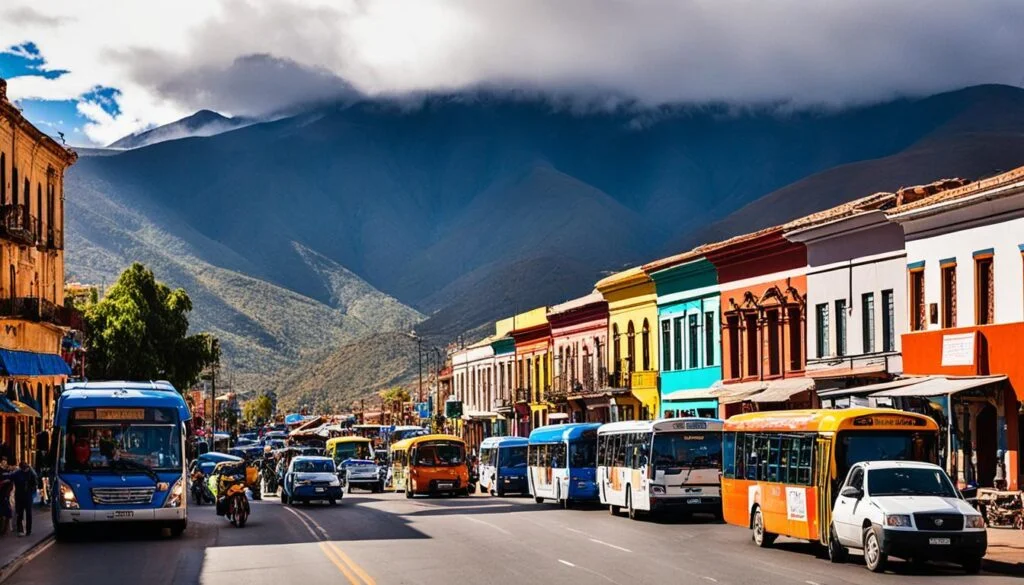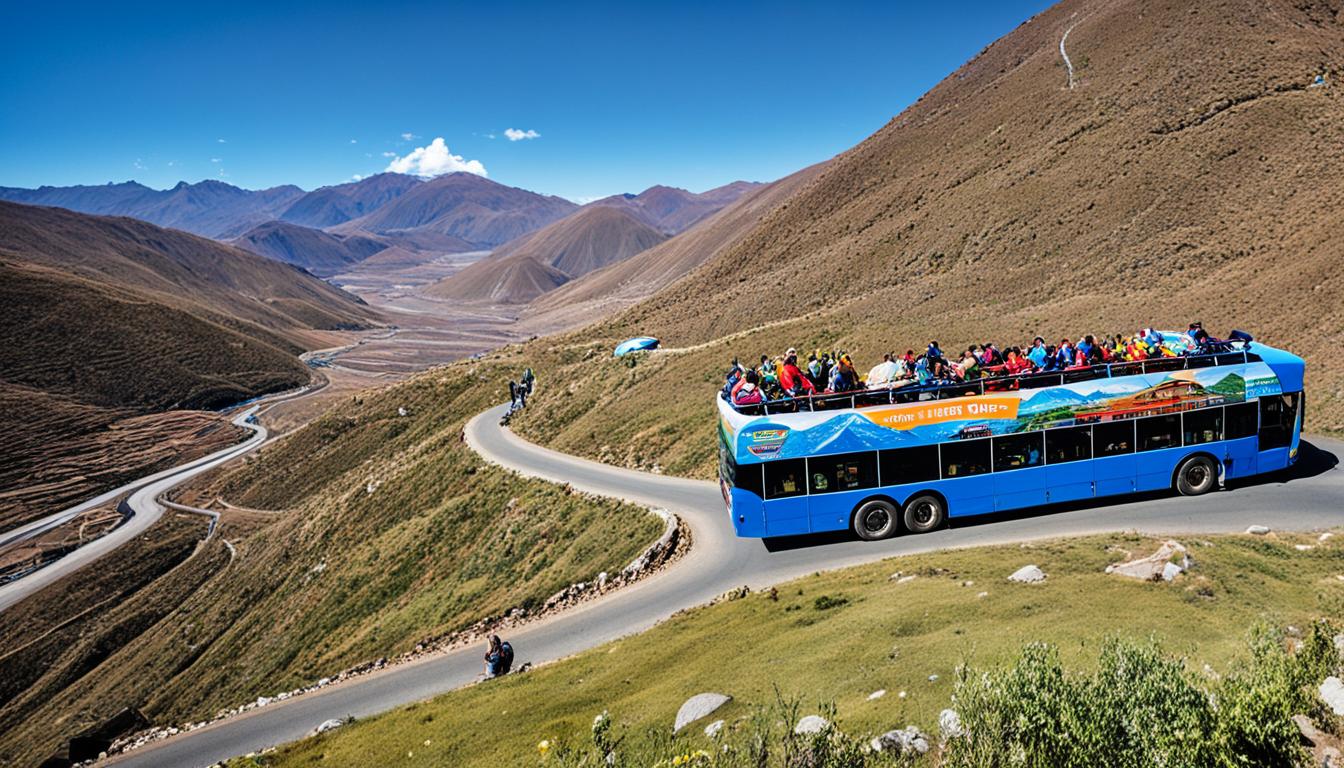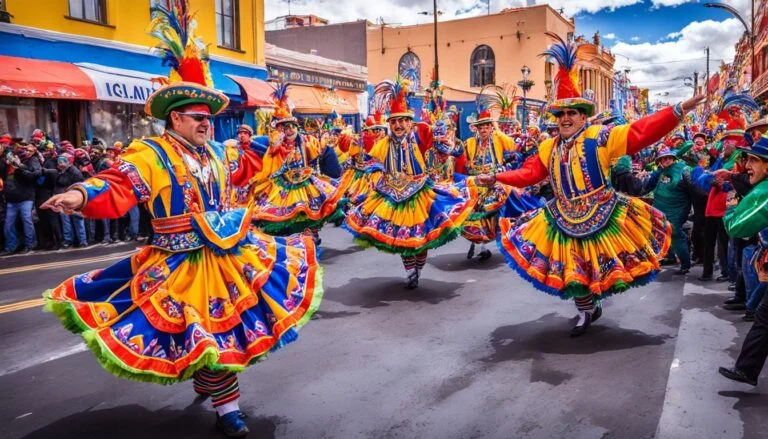Bolivia Transportation Guide: Tips & Options
Are you ready to explore the scenic landscapes of Bolivia? But wait, how do you navigate this vast country with its challenging roads and limited infrastructure? Don’t worry, we’ve got you covered. In this transportation guide, we’ll reveal the best ways to get around in Bolivia, share essential tips, and provide insights into the Bolivian transportation network. So, put on your adventurous spirit and let’s dive into the world of Bolivia’s transportation options.
Key Takeaways:
- Getting around Bolivia can be challenging due to poor road conditions and limited infrastructure.
- Most Bolivians use buses as their primary mode of transportation, offering a good value for money.
- Air travel is available for faster journeys between major cities, but it can be expensive.
- Taxis, cable cars, motorcycles, micros (minibuses), and lorries are other transportation options in Bolivia.
- Flexibility and planning are crucial when traveling in Bolivia, as road conditions and delays can affect your journey.
Traveling by Bus
When it comes to getting around Bolivia, buses are the most common and affordable mode of transportation. Bolivia’s bus network, known as flotas, is managed by private companies and serves most destinations across the country.
Despite their affordability, it’s important to note that the condition of the roads in Bolivia can be quite poor. This means that bus journeys can be bumpy and uncomfortable at times. However, traveling by bus allows you to experience the scenic landscapes of Bolivia and immerse yourself in the local culture.
Buses in Bolivia offer different seat types, ranging from basic to more comfortable options. Some buses even provide reclining seats and personal TVs for entertainment during the journey. However, it’s important to keep in mind that breakdowns are common, and delays are to be expected. So, it’s advisable to plan your itinerary with some flexibility in mind.
During bus trips, there are regular meal breaks where passengers can purchase food and drinks. However, it’s always a good idea to carry your own snacks to ensure you have something to eat if the available options don’t suit your preferences. Additionally, it can get chilly during bus rides, especially at higher altitudes or during nighttime journeys. So, packing warm clothing is essential for your comfort.
To have a smoother ride, try to avoid sitting at the back of the bus. The rear seats tend to experience more vibrations and bumps due to the road conditions. Choosing a seat closer to the front can provide a relatively smoother and more comfortable journey.
If you prefer a budget-friendly and adventurous way to explore Bolivia, traveling by bus is an excellent choice. Just be prepared for rough roads, plan your journey with some flexibility, and embrace the breathtaking landscapes along the way.
Air Travel

If you’re looking for a faster way to travel between major cities in Bolivia and save time, air travel is the way to go. Regular internal flights are available to most major cities, providing convenience and efficiency.
The main carrier for air travel in Bolivia is Boliviana de Aviacion, offering a wide range of domestic routes. Another operator called Amaszonas also provides internal flights, expanding the options for travelers. Additionally, the Bolivian air force operates passenger services, ensuring a reliable transportation network.
However, it’s important to note that flights in Bolivia can be subject to delays and cancellations, especially in the Amazon region where weather conditions can be unpredictable. It’s a good idea to keep this in mind when planning your air travel itinerary.
When traveling by air in Bolivia, it’s essential to be aware of the baggage allowance. Typically, the standard baggage allowance is 15kg, and there may be additional charges for excess weight. Make sure to check the specific guidelines of the airline you’re flying with to avoid any surprises at the airport.
Overall, air travel offers a quicker and more convenient option for navigating Bolivia’s extensive transportation network. It’s a great way to save time, especially when traveling between major cities.
| Pros | Cons |
|---|---|
| Fast and efficient | Potential for flight delays and cancellations, especially in the Amazon region |
| Wide range of domestic routes | Baggage restrictions and additional charges for excess weight |
| Reliable transportation network |
Other Modes of Transportation

When it comes to getting around Bolivia, there are several transportation options available to suit different needs and preferences. Whether you’re navigating the bustling city streets or venturing into remote areas, here are some popular modes of transportation in Bolivia:
Taxis
Taxis are a convenient and safe way to travel within cities in Bolivia. They are readily available and can be hailed on the street or found at designated taxi stands. To ensure a safer option, you can opt for radio taxis, which can be called or requested via mobile apps.
Renting a Car
Renting a car is possible in Bolivia, but it’s not a common mode of transportation due to the country’s road conditions and infrastructure challenges. However, if you prefer the freedom and flexibility of having your own vehicle, rental options are available. Keep in mind that road conditions can be rough, so it’s important to choose a sturdy vehicle and drive with caution.
Cable Cars
One unique mode of transportation in Bolivia is the cable car system, particularly in La Paz. These cable cars offer a scenic and efficient way to travel around the city, providing breathtaking views of the surrounding mountains and urban landscapes. They are a popular choice for both locals and tourists.
Motorcycles
While less common than other modes of transport, motorcycles can be an exciting and adventurous way to explore Bolivia. They are particularly popular for guided tours, allowing visitors to experience the country’s diverse landscapes and hidden gems in a thrilling way. Make sure to wear appropriate safety gear and follow local traffic regulations.
Micros (Minibuses)
In urban areas, micros or minibuses are the main form of public transport. These vehicles are affordable but can be crowded, especially during peak hours. Micros follow set routes and pick up passengers along the way. They are a budget-friendly option for getting around cities and towns in Bolivia.
Lorries (Camiones)
In more remote areas of Bolivia, lorries or camiones are commonly used for transportation. These large trucks serve as a means of transportation for both goods and passengers. While not the most comfortable option, they can be a practical choice for reaching off-the-beaten-path destinations.
Trains
Trains are less common in Bolivia compared to other modes of transportation, but they offer scenic journeys and a unique travel experience. The most famous train route in Bolivia is the Uyuni Salt Flats to Oruro route, where travelers can admire the stunning landscapes of the salt flats and surrounding area.
| Transportation Mode | Advantages | Disadvantages |
|---|---|---|
| Taxis | – Convenient and readily available – Safe mode of transport | – Cost can add up with longer distances – Potential language barrier with drivers |
| Renting a Car | – Freedom and flexibility – Easy access to remote areas | – Poor road conditions – Limited rental options and availability |
| Cable Cars | – Scenic views – Efficient way to navigate cities | – Limited coverage within city limits |
| Motorcycles | – Exciting and adventurous – Ideal for guided tours | – Requires experience in riding motorcycles – Potential safety risks |
| Micros (Minibuses) | – Budget-friendly option – Wide coverage within urban areas | – Crowded during peak hours – Limited schedule flexibility |
| Lorries (Camiones) | – Practical for remote areas – Opportunity to interact with locals | – Lack of comfort – Irregular schedules |
| Trains | – Scenic journeys – Unique travel experience | – Limited routes and frequency – Potential delays |
These transportation options cater to different travel preferences and destinations in Bolivia. Consider the pros and cons of each mode of transportation to make the best choice for your journey.
Conclusion
Navigating Bolivia’s transportation options can be both challenging and rewarding. With its diverse topography and limited infrastructure, traveling within Bolivia requires careful planning and flexibility. The country’s extensive bus network serves as the primary mode of transportation, offering different seat options to suit various preferences.
For those seeking faster travel between major cities, air travel is available, although it can be more expensive. Boliviana de Aviacion and Amaszonas are the main airlines operating domestic flights. However, it’s important to be aware that flights can be subject to delays and cancellations, particularly in the Amazon region where weather conditions can impact travel.
Alternatively, taxis, cable cars, and motorcycles provide additional transportation options for shorter distances or more unique experiences. In urban areas, micros and trufis (minibuses) offer cheap and efficient means of getting around. In remote areas, lorries and trains are utilized for transportation, often providing scenic routes that allow travelers to appreciate the country’s natural beauty.
While exploring Bolivia’s transportation options, it is crucial to plan ahead and remain flexible. Road conditions and unforeseen circumstances can affect travel times, so it’s advisable to allow for extra time and avoid rigid itineraries. By considering these transportation tips and options, travelers can navigate Bolivia’s vast landscapes with confidence and make the most of their adventure.






